国际贸易术语解释通则2010之CFR(中英对照版)
国际贸易术语解释通则2010之CFR(中英对照版)

COST AND FREIGHT 成本加运费CFR (insert named port of destination) Incoterms 2010 成本加运费(…指定目的港) GUIDANCE NOTE 序言This rule is to be used only for sea or inland waterway transport. “Cost and Freight” means that t he seller delivers the goods on board the vessel or procures the goods already so delivered. The ri sk of loss of or damage to the goods passes when the goods are on board the vessel.该术语仅适用于海运或内河运输。
“Cost and Freight”是指当卖方将货物运至船上或取得已按此送交的货物,即完成交货。
当货物已运至船上时,货物灭失或损坏的风险发生转移。
The seller must contract for and pay the costs and freight necessary to bring the goods to the na med port of destination.卖方还必须订立货物运至指定目的港的合同并支付成本和运费。
When CPT, CIP, CFR or CIF are used, the seller fulfils its obligation to deliver when it hands the goo ds over to the carrier in the manner specified in the chosen rule and not when the goods reach th e place of destination.当使用CPT, CIP, CFR 或 CIF等术语时,卖方承担其将货物按照所选规则指定的方式交付承运人前所有风险和费用,而当货物运至指定目的地后,由买方承担一切风险和费用。
2010新版国际贸易术语解释通则(中英文版)

国际贸易术语解释通则(2010)法政学院11法61许艳文目录前言. 1EXW——工厂交货(……指定地点). 5FCA——货交承运人(……指定地点). 7CPT——运费付至(……指定目的港). 10CIP——运费和保险费付至(……指定目的地)13DAT——终点站交货(……指定目的港或目的地)16DAP——目的地交货(……指定目的地). 18DDP——完税后交货(……指定目的地). 20FAS——船边交货(……指定装运港). 22FOB——船上交货(……指定装运港). 24CFR——成本加运费付至(……指定目的港)27CIF——成本,保险加运费付至(……指定目的港)30国际贸易术语解释通则2010全球化经济赋予商业以空前宽广途径通往世界各地市场。
货物得以在更多的国家、大量且种类愈繁地销售。
然而随着全球贸易数额的增加与贸易复杂性的提升,因销售合同不恰当起草引致误解与高代价争端可能性也提高了。
国际贸易术语解释通则这一用于国内与国际贸易事项的国际商会规则使得全球贸易行为更便捷。
在销售合同中参引国际贸易术语解释通则2010可清晰界定各方义务并降低法律纠纷的风险。
自1936年国际商会创制国际贸易术语以来,这项在全球范围内普遍被接受的合同标准经常更新,以保持与国际贸易发展步调一致。
国际贸易术语解释通则2010版考虑到了全球范围内免税区的扩展,商业交往中电子通讯运用的增多,货物运输中安保问题关注度的提高以及运输实践中的许多变化。
国际贸易术语解释通则2010更新并加强了“交货规则”——规则的总数从13降到11,并为每一规则提供了更为简洁和清晰的解释。
国际贸易术语解释通则2010同时也是第一部使得所有解释对买方与卖方呈现中立的贸易解释版本。
国际商会商法和实践委员会成员来自世界各地和所有贸易领域,该委员会宽泛的专业技能确保了国际贸易术语解释通则2010与各地的商贸需要照应。
国际商会向Fabio Bortolotti(意大利)的商法和实践委员会的成员表示谢意,向由Charles Debattista(副组长,英国),Christoph Martin Radtke (副组长,法国),Jens Bredow (德国),Johnny Herre (瑞典),David Lwee(英国),Lauri Railas (芬兰),Frank Reynold(美国),Miroslav Subert (捷克)组成的起草小组致谢,并且向对11条规则的表述给予帮助的Asko Raty (芬兰)致谢。
2010国际贸易术语解释通则(中文完整版)

2010年国际贸易术语解释通则(INCOTERMS 2010)目录1. 2010年国际贸易术语解释通则(INCOTERMS 2010)引占EXWFCACPT ClPDAT DAP DDP FAS FOB CFR CIF《2010年国际贸易术语解释通则》中文版INCOTERMS 2010• (2011年1月第二版)引言适用于任何单一运输方式或多种运输方式的术语EXW (EX WOrkS)工厂交货FCA (Free Carner)货交承运人CPT (Carriage Paid TO)运费付至CIP (Carriage and InSUranCe PaiCl to)运费、保险费付至DAT (DeliVereel At TerminaI)运输终端交货DAP (DeliVered At PlaCe) U 的地交货DDP (DeliVered DUty Paiel)完税后交货 适用于海运和内河水运的术语FAS (Free AlOng Side)船边交货 FOB (Free On BOard)船上交货CFR (COSt and Freight)成本加运费1. 2. 3. 4. 5. 6.7. 8.9. 1011CIF (Cost, InSUranCe and Freight)成本、保险加运费EXW(EX WOrkS工厂交货)该术语可适用于任何运输方式,也可适用于多种运输方式。
它适合国内贸易,而FCA-般则更适合国际贸易。
“工厂交货”是指当卖方在其所在地或其它指定地点(如工厂、车间或仓库等)将货物交ill买方处置时,即完成交货。
卖方不需将货物装上任何前来接收货物的运输工具,需要清关时,卖方也无需办理出口清关手续。
特别建议双方在指定交货地范围内尽可能明确具体交货地点,因为在货物到达交货地点之前的所有费用和风险都Ili卖方承担。
买方则需承担自此指定交货地的约定地点(如有的话)收取货物所产生的全部费用和风险。
EXW (工厂交货)术语代表卖方最低义务,使用时需注意以下问题:a)卖方对买方没有装货的义务,即使实际上卖方也许更方便这样做。
国际贸易术语解释通则2010之FCA(中英对照版)

Free Carrier 货交承运人FCA (insert named place of delivery) Incoterms 2010 货交承运人(…指定地点) GUIDANCE NOTE 序言This rule may be used irrespective of the mode of transport selected and may also be used where more than one mode of transport is employed. “Free Carrier” means that the seller delivers the goods to the carrier or another person nominated by the buyer at the seller’s premises or anothe r named place. The parties are well advised to specify as clearly as possible the point within the n amed place of delivery, as the risk passes to the buyer at that point. If the parties intend to delive r the goods at the seller’s premises, they should identify the address of those premises as the na med place of delivery. If, on the other hand, the parties intend the goods to be delivered at anoth er place, they must identify a different specific place of delivery. FCA requires the seller to clear t he goods for export, where applicable.However, the seller has no obligation to clear the goods for import, pay any import duty or carry out any import customs formalities.该术语适用于所选择的任一运输方式,也可被用于多式联运。
2010新版国际贸易术语解释通则中英文版.doc
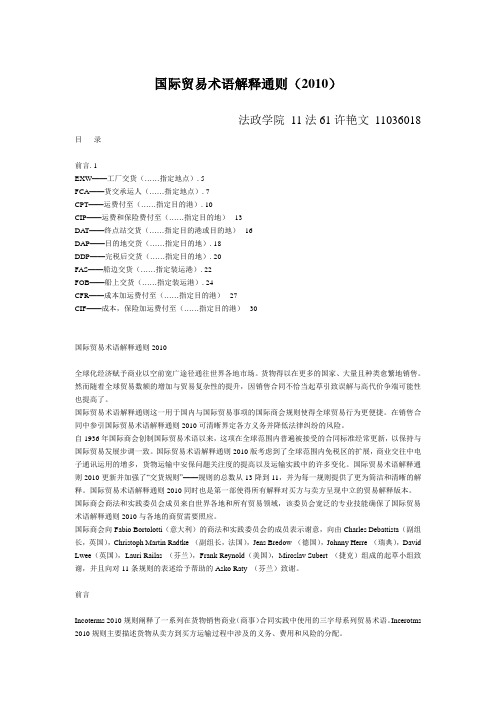
国际贸易术语解释通则(2010)法政学院11法61许艳文11036018 目录前言. 1EXW——工厂交货(……指定地点). 5FCA——货交承运人(……指定地点). 7CPT——运费付至(……指定目的港). 10CIP——运费和保险费付至(……指定目的地)13DAT——终点站交货(……指定目的港或目的地)16DAP——目的地交货(……指定目的地). 18DDP——完税后交货(……指定目的地). 20FAS——船边交货(……指定装运港). 22FOB——船上交货(……指定装运港). 24CFR——成本加运费付至(……指定目的港)27CIF——成本,保险加运费付至(……指定目的港)30国际贸易术语解释通则2010全球化经济赋予商业以空前宽广途径通往世界各地市场。
货物得以在更多的国家、大量且种类愈繁地销售。
然而随着全球贸易数额的增加与贸易复杂性的提升,因销售合同不恰当起草引致误解与高代价争端可能性也提高了。
国际贸易术语解释通则这一用于国内与国际贸易事项的国际商会规则使得全球贸易行为更便捷。
在销售合同中参引国际贸易术语解释通则2010可清晰界定各方义务并降低法律纠纷的风险。
自1936年国际商会创制国际贸易术语以来,这项在全球范围内普遍被接受的合同标准经常更新,以保持与国际贸易发展步调一致。
国际贸易术语解释通则2010版考虑到了全球范围内免税区的扩展,商业交往中电子通讯运用的增多,货物运输中安保问题关注度的提高以及运输实践中的许多变化。
国际贸易术语解释通则2010更新并加强了“交货规则”——规则的总数从13降到11,并为每一规则提供了更为简洁和清晰的解释。
国际贸易术语解释通则2010同时也是第一部使得所有解释对买方与卖方呈现中立的贸易解释版本。
国际商会商法和实践委员会成员来自世界各地和所有贸易领域,该委员会宽泛的专业技能确保了国际贸易术语解释通则2010与各地的商贸需要照应。
国际商会向Fabio Bortolotti(意大利)的商法和实践委员会的成员表示谢意,向由Charles Debattista(副组长,英国),Christoph Martin Radtke (副组长,法国),Jens Bredow (德国),Johnny Herre (瑞典),David Lwee(英国),Lauri Railas (芬兰),Frank Reynold(美国),Miroslav Subert (捷克)组成的起草小组致谢,并且向对11条规则的表述给予帮助的Asko Raty (芬兰)致谢。
国际贸易术语解释通则2010之FCA(中英对照版)
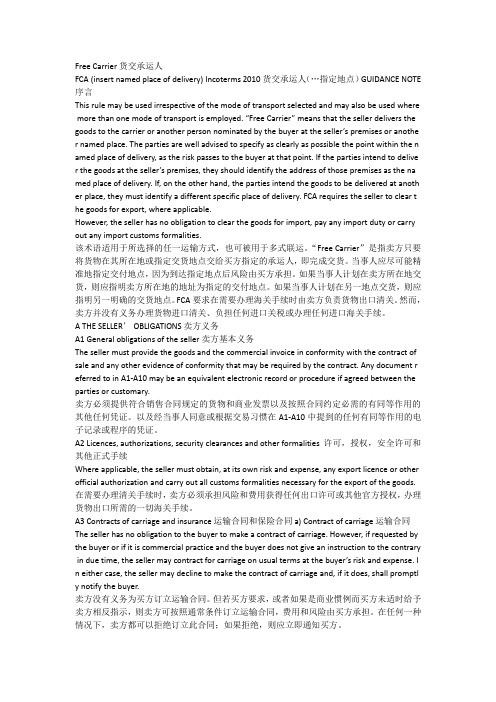
Free Carrier 货交承运人FCA (insert named place of delivery) Incoterms 2010 货交承运人(…指定地点) GUIDANCE NOTE 序言This rule may be used irrespective of the mode of transport selected and may also be used where more than one mode of transport is employed. “Free Carrier” means that the seller delivers the goods to the carrier or another person nominated by the buyer at the seller’s premises or anothe r named place. The parties are well advised to specify as clearly as possible the point within the n amed place of delivery, as the risk passes to the buyer at that point. If the parties intend to delive r the goods at the seller’s premises, they should identify the address of those premises as the na med place of delivery. If, on the other hand, the parties intend the goods to be delivered at anoth er place, they must identify a different specific place of delivery. FCA requires the seller to clear t he goods for export, where applicable.However, the seller has no obligation to clear the goods for import, pay any import duty or carry out any import customs formalities.该术语适用于所选择的任一运输方式,也可被用于多式联运。
Incoterms-2010-国际贸易术语中英文对照解释(全)

EXW (insert named place of delivery)GUIDANCE NOTEThis rule may be used irrespective of the mode of transport selected and may also be used where more than one mode of transport is employed.It is suitable for domestic trade, while FCA is usually more appropriate for international trade.“Ex Works” means that the seller delivers when it places the goods at the disposal of the buyer at the seller’s premises or a t another named place (i.e., works, factory, warehouse, etc.). The seller does not need to load the goods on any collecting vehicle, nor does it need to clear the goods for export, where such clearance is applicable.The parties are well advised to specify as clearly as possible the point within the named place of delivery, as the costs and risks to that point are for the account of the seller. The buyer bears all costs and risks involved in taking the goods from the agreed point, if any, at the named place of delivery.EXW represents the minimum obligation for the seller. The rule should be used with care as:a) The seller has no obligation to the buyer to load the goods, even though in practice the seller may be in a betterposition to do so. If the seller does load the goods, it does so at the buyer’s risk and expense. In cases where the seller i s in a better position to load the goods, FCA, which obliges the seller to do so at its own risk and expense, is usually more appropriate.b) A buyer who buys from a seller on an EXW basis for export needs to be aware that the seller has an obligation toprovide only such assistance as the buyer may require to effect that export: the seller is not bound to organize the export clearance. Buyers are therefore well advised not to use EXW if they cannot directly or indirectly obtain export clearance.c) The buyer has limited obligations to provide to the seller any information regarding the export of the goods. However,the seller may need this information for, e.g., taxation or reporting purposes.EXW——工厂交货(……指定地点)本条规则与(当事人)所选择的运输模式无关,即便(当事人)选择多种运输模式,亦可适用该规则。
(完整版)Incoterms-2010-国际贸易术语中英文对照解释(全)

EXW (insert named place of delivery)GUIDANCE NOTEThis rule may be used irrespective of the mode of transport selected and may also be used where more than one mode of transport is employed.It is suitable for domestic trade, while FCA is usually more appropriate for international trade.“Ex Works” means that the seller delivers when it places the goods at the disposal of the buyer at the seller’s premises or a t another named place (i.e., works, factory, warehouse, etc.). The seller does not need to load the goods on any collecting vehicle, nor does it need to clear the goods for export, where such clearance is applicable.The parties are well advised to specify as clearly as possible the point within the named place of delivery, as the costs and risks to that point are for the account of the seller. The buyer bears all costs and risks involved in taking the goods from the agreed point, if any, at the named place of delivery.EXW represents the minimum obligation for the seller. The rule should be used with care as:a) The seller has no obligation to the buyer to load the goods, even though in practice the seller may be in a betterposition to do so. If the seller does load the goods, it does so at the buyer’s risk and expense. In cases where the seller i s in a better position to load the goods, FCA, which obliges the seller to do so at its own risk and expense, is usually more appropriate.b) A buyer who buys from a seller on an EXW basis for export needs to be aware that the seller has an obligation toprovide only such assistance as the buyer may require to effect that export: the seller is not bound to organize the export clearance. Buyers are therefore well advised not to use EXW if they cannot directly or indirectly obtain export clearance.c) The buyer has limited obligations to provide to the seller any information regarding the export of the goods. However,the seller may need this information for, e.g., taxation or reporting purposes.EXW——工厂交货(……指定地点)本条规则与(当事人)所选择的运输模式无关,即便(当事人)选择多种运输模式,亦可适用该规则。
2010新版国际贸易术语解释通则(中英文版)

国际贸易术语解释通则(2010)法政学院11法61许艳文目录前言. 1EXW——工厂交货(……指定地点). 5FCA——货交承运人(……指定地点). 7CPT——运费付至(……指定目的港). 10CIP——运费和保险费付至(……指定目的地)13DAT——终点站交货(……指定目的港或目的地)16DAP——目的地交货(……指定目的地). 18DDP——完税后交货(……指定目的地). 20FAS——船边交货(……指定装运港). 22FOB——船上交货(……指定装运港). 24CFR——成本加运费付至(……指定目的港)27CIF——成本,保险加运费付至(……指定目的港)30国际贸易术语解释通则2010全球化经济赋予商业以空前宽广途径通往世界各地市场。
货物得以在更多的国家、大量且种类愈繁地销售。
然而随着全球贸易数额的增加与贸易复杂性的提升,因销售合同不恰当起草引致误解与高代价争端可能性也提高了。
国际贸易术语解释通则这一用于国内与国际贸易事项的国际商会规则使得全球贸易行为更便捷。
在销售合同中参引国际贸易术语解释通则2010可清晰界定各方义务并降低法律纠纷的风险。
自1936年国际商会创制国际贸易术语以来,这项在全球范围内普遍被接受的合同标准经常更新,以保持与国际贸易发展步调一致。
国际贸易术语解释通则2010版考虑到了全球范围内免税区的扩展,商业交往中电子通讯运用的增多,货物运输中安保问题关注度的提高以及运输实践中的许多变化。
国际贸易术语解释通则2010更新并加强了“交货规则”——规则的总数从13降到11,并为每一规则提供了更为简洁和清晰的解释。
国际贸易术语解释通则2010同时也是第一部使得所有解释对买方与卖方呈现中立的贸易解释版本。
国际商会商法和实践委员会成员来自世界各地和所有贸易领域,该委员会宽泛的专业技能确保了国际贸易术语解释通则2010与各地的商贸需要照应。
国际商会向Fabio Bortolotti(意大利)的商法和实践委员会的成员表示谢意,向由Charles Debattista(副组长,英国),Christoph Martin Radtke (副组长,法国),Jens Bredow (德国),Johnny Herre (瑞典),David Lwee(英国),Lauri Railas (芬兰),Frank Reynold(美国),Miroslav Subert (捷克)组成的起草小组致谢,并且向对11条规则的表述给予帮助的Asko Raty (芬兰)致谢。
2010新版国际贸易术语解释通则(中英文版)

国际贸易术语解释通则(2010)目录前言. 1EXW——工厂交货(……指定地点). 5FCA——货交承运人(……指定地点). 7CPT——运费付至(……指定目的港). 10CIP——运费和保险费付至(……指定目的地)13DAT——终点站交货(……指定目的港或目的地)16DAP——目的地交货(……指定目的地). 18DDP——完税后交货(……指定目的地). 20FAS——船边交货(……指定装运港). 22FOB——船上交货(……指定装运港). 24CFR——成本加运费付至(……指定目的港)27CIF——成本,保险加运费付至(……指定目的港)30国际贸易术语解释通则2010全球化经济赋予商业以空前宽广途径通往世界各地市场。
货物得以在更多的国家、大量且种类愈繁地销售。
然而随着全球贸易数额的增加与贸易复杂性的提升,因销售合同不恰当起草引致误解与高代价争端可能性也提高了。
国际贸易术语解释通则这一用于国内与国际贸易事项的国际商会规则使得全球贸易行为更便捷。
在销售合同中参引国际贸易术语解释通则2010可清晰界定各方义务并降低法律纠纷的风险。
自1936年国际商会创制国际贸易术语以来,这项在全球范围内普遍被接受的合同标准经常更新,以保持与国际贸易发展步调一致。
国际贸易术语解释通则2010版考虑到了全球范围内免税区的扩展,商业交往中电子通讯运用的增多,货物运输中安保问题关注度的提高以及运输实践中的许多变化。
国际贸易术语解释通则2010更新并加强了―交货规则‖——规则的总数从13降到11,并为每一规则提供了更为简洁和清晰的解释。
国际贸易术语解释通则2010同时也是第一部使得所有解释对买方与卖方呈现中立的贸易解释版本。
国际商会商法和实践委员会成员来自世界各地和所有贸易领域,该委员会宽泛的专业技能确保了国际贸易术语解释通则2010与各地的商贸需要照应。
国际商会向Fabio Bortolotti(意大利)的商法和实践委员会的成员表示谢意,向由Charles Debattista(副组长,英国),Christoph Martin Radtke (副组长,法国),Jens Bredow (德国),Johnny Herre (瑞典),David Lwee(英国),Lauri Railas (芬兰),Frank Reynold(美国),Miroslav Subert (捷克)组成的起草小组致谢,并且向对11条规则的表述给予帮助的Asko Raty (芬兰)致谢。
Incoterms2010国际贸易术语解释通则2010(中文版)

附录一:《2010年国际贸易术语解释通则®》(Incoterms®2010)(国际商会第715号出版物)2011年1月1日开始实施一、 E XW EX WORKS( named place of delivery)工厂交货(……指定交货地)EXW贸易术语适用于任何运输方式,是指卖方于其营业处所或其他指定地(即工场,工厂,仓库等)交由买方处置时,即属卖方交货完成。
卖方无须将货物装上任何收货的运送工具,亦无须办理货物出口的通关手续。
工厂交货贸易术语表示卖方最小责任。
A卖方的义务A1卖方的一般义务卖方必须要提供符合买卖合同约定的货物及商业发票,以及任何契约可能要求的其他任何符合证据。
A1至A10中所提及的任何单据,如当事人协商一致或已有惯例,均可为具有同等法律效力的电子记录或程序。
A2许可证、批准书、安全通过及其他手续当需要办理通关手续时,卖方必须要应买方请求,并由买方负担风险及费用,提供买方协助以取得货物输出所需要的任何出口许可证或其他官方批准文件,及提供为卖方所有并为货物安全通关所需的任何信息。
A3货物运输与保险卖方没有为买方订立运输契约和保险契约的义务。
然而卖方必须要遵循买方的请求,并由买方承担费用和风险(如有),提供买方为获得保险所需的信息。
A4交货卖方必须要于指定交货地,在约定地点(如有),将尚未装上任何收货运输工具的货物交由买方处置。
如在指定的交货地内未经约定特定的交货地点,且如有数处交货地可供选择时,卖方可以选择最合适的交货地点。
卖方必须要在约定的日期或者期间内交付货物。
A5 风险转移卖方负责货物交付前的一切风险,但B5项所述状况货物的灭失或毁损不在此列。
A6 费用的划分卖方必须要承担货物交付前的一切费用,但B6中所列情形应由买方支付除外。
A7通知买方卖方必须要给予买方任何所需的通知,以便买方能够提取货物。
A8 交货单据卖方没有该项义务(指发票或汇票以外的交货单据,比如提单、通关相关单据等)A9 检查、包装和标示卖方需要支付为依据A4项交付货物所需的检查(如检查品质、丈量、过磅和计数)等费用。
Incoterms-2010-国际贸易术语中英文对照解释(全)

EXW (insert named place of delivery)GUIDANCE NOTEThis rule may be used irrespective of the mode of transport selected and may also be used where more than one mode of transport is employed.It is suitable for domestic trade, while FCA is usually more appropriate for international trade.“Ex Works” means that the seller delivers when it places the goods at the disposal of the buyer at the seller’s premises or at another named place (i.e., works, factory, warehouse, etc.). The seller does not need to load the goods on any collecting vehicle, nor does it need to clear the goods for export, where such clearance is applicable.The parties are well advised to specify as clearly as possible the point within the named place of delivery, as the costs and risks to that point are for the account of the seller. The buyer bears all costs and risks involved in taking the goods from the agreed point, if any, at the named place of delivery.EXW represents the minimum obligation for the seller. The rule should be used with care as:a) The seller has no obligation to the buyer to load the goods, even though in practice the seller may be in a betterposition to do so. If the seller does load the goods, it does so at the buyer’s risk and expense. In cases where the seller i s in a better position to load the goods, FCA, which obliges the seller to do so at its own risk and expense, is usually more appropriate.b) A buyer who buys from a seller on an EXW basis for export needs to be aware that the seller has an obligation toprovide only such assistance as the buyer may require to effect that export: the seller is not bound to organize the export clearance. Buyers are therefore well advised not to use EXW if they cannot directly or indirectly obtain export clearance.c) The buyer has limited obligations to provide to the seller any information regarding the export of the goods. However,the seller may need this information for, e.g., taxation or reporting purposes.EXW——工厂交货(……指定地点)本条规则与(当事人)所选择的运输模式无关,即便(当事人)选择多种运输模式,亦可适用该规则。
Incoterms2010国际贸易术语中英文对照解释全
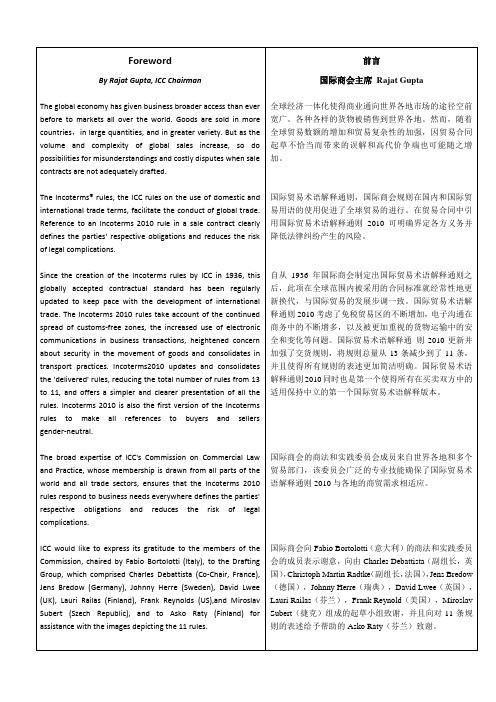
EXW (insert named place of delivery)GUIDANCE NOTEThis rule may be used irrespective of the mode of transport selected and may also be used where more than one mode of transport is employed.It is suitable for domestic trade, while FCA is usually more appropriate for international trade.“Ex Works” means that the seller delivers when it places the goods at the disposal of the buyer at the seller’s premises or at another named place (i.e., works, factory, warehouse, etc.). The seller does not need to load the goods on any collecting vehicle, nor does it need to clear the goods for export, where such clearance is applicable.The parties are well advised to specify as clearly as possible the point within the named place of delivery, as the costs and risks to that point are for the account of the seller. The buyer bears all costs and risks involved in taking the goods from the agreed point, if any, at the named place of delivery.EXW represents the minimum obligation for the seller. The rule should be used with care as:a) The seller has no obligation to the buyer to load the goods, even though in practice the seller may be in a betterposition to do so. If the seller does load the goods, it does so at the buyer’s risk and expense. In cases where the seller i s in a better position to load the goods, FCA, which obliges the seller to do so at its own risk and expense, is usually more appropriate.b) A buyer who buys from a seller on an EXW basis for export needs to be aware that the seller has an obligation toprovide only such assistance as the buyer may require to effect that export: the seller is not bound to organize the export clearance. Buyers are therefore well advised not to use EXW if they cannot directly or indirectly obtain export clearance.c) The buyer has limited obligations to provide to the seller any information regarding the export of the goods. However,the seller may need this information for, e.g., taxation or reporting purposes.EXW——工厂交货(……指定地点)本条规则与(当事人)所选择的运输模式无关,即便(当事人)选择多种运输模式,亦可适用该规则。
2010年国际贸易术语解释通则(中文完整版)解析
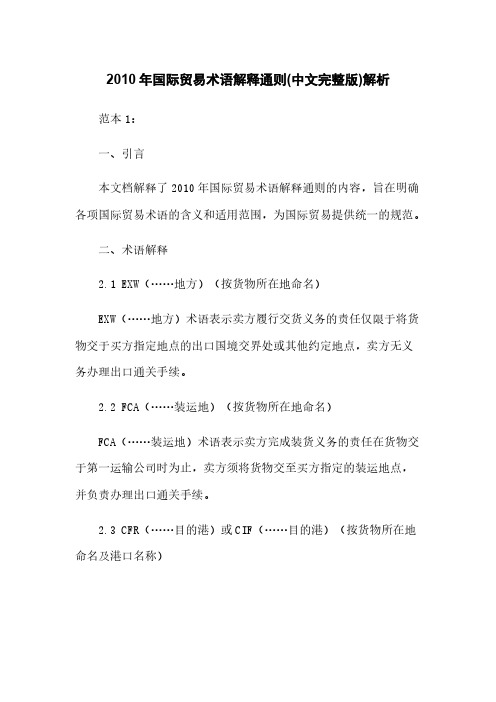
2010年国际贸易术语解释通则(中文完整版)解析范本1:一、引言本文档解释了2010年国际贸易术语解释通则的内容,旨在明确各项国际贸易术语的含义和适用范围,为国际贸易提供统一的规范。
二、术语解释2.1 EXW(……地方)(按货物所在地命名)EXW(……地方)术语表示卖方履行交货义务的责任仅限于将货物交于买方指定地点的出口国境交界处或其他约定地点,卖方无义务办理出口通关手续。
2.2 FCA(……装运地)(按货物所在地命名)FCA(……装运地)术语表示卖方完成装货义务的责任在货物交于第一运输公司时为止,卖方须将货物交至买方指定的装运地点,并负责办理出口通关手续。
2.3 CFR(……目的港)或CIF(……目的港)(按货物所在地命名及港口名称)CFR(……目的港)或CIF(……目的港)术语表示卖方负责交货义务直到将货物交至目的港的船上,并负责办理出口通关手续,但不负责货物进入目的港的进口通关和支付目的港的进口费用。
3、附件本文档涉及的附件包括以下内容:附件1:国际贸易术语解释通则2010年完整版(中文版)附件2:国际贸易术语解释通则2010年完整版(英文版)附件3:国际贸易术语解释通则2010年常见问题解答4、法律名词及注释4.1 国际贸易术语解释通则:国际商会发布的关于国际贸易术语的准则,旨在统一术语的含义和适用范围。
4.2 EXW:指货物出厂价。
4.3 FCA:指卖方完成装货义务的责任。
4.4 CFR:指卖方负责交货义务直到将货物交至目的港的船上。
------------------------------------------------------------范本2:一、前言本文档是2010年国际贸易术语解释通则的解析,目的是明确各个国际贸易术语的定义和适用情况,为全球贸易提供规范和参考。
二、术语解释2.1 EXW(……地方)(按货物所在地命名)EXW术语表示卖方将货物交由买方指定的地点进行交接,卖方无义务办理出口通关手续。
Incoterms-2010-国际贸易术语中英文对照解释(全)

EXW (insert named place of delivery)GUIDANCE NOTEThis rule may be used irrespective of the mode of transport selected and may also be used where more than one mode of transport is employed.It is suitable for domestic trade, while FCA is usually more appropriate for international trade.“Ex Works” means that the seller delivers when it places the goods at the disposal of the buyer at the seller’s premises or a t another named place (i.e., works, factory, warehouse, etc.). The seller does not need to load the goods on any collecting vehicle, nor does it need to clear the goods for export, where such clearance is applicable.The parties are well advised to specify as clearly as possible the point within the named place of delivery, as the costs and risks to that point are for the account of the seller. The buyer bears all costs and risks involved in taking the goods from the agreed point, if any, at the named place of delivery.EXW represents the minimum obligation for the seller. The rule should be used with care as:a) The seller has no obligation to the buyer to load the goods, even though in practice the seller may be in a betterposition to do so. If the seller does load the goods, it does so at the buyer’s risk and expense. In cases where the seller i s in a better position to load the goods, FCA, which obliges the seller to do so at its own risk and expense, is usually more appropriate.b) A buyer who buys from a seller on an EXW basis for export needs to be aware that the seller has an obligation toprovide only such assistance as the buyer may require to effect that export: the seller is not bound to organize the export clearance. Buyers are therefore well advised not to use EXW if they cannot directly or indirectly obtain export clearance.c) The buyer has limited obligations to provide to the seller any information regarding the export of the goods. However,the seller may need this information for, e.g., taxation or reporting purposes.EXW——工厂交货(……指定地点)本条规则与(当事人)所选择的运输模式无关,即便(当事人)选择多种运输模式,亦可适用该规则。
2010年国际贸易术语解释通则(中文完整版)

2010年国际贸易术语解释通则(INCOTERMS 2010)目录1.2010年国际贸易术语解释通则(INCOTERMS 2010)1.引言2.EXW3.FCA4.CPT5.CIP6.DAT7.DAP8.DDP9.FAS10.FOB11.CFR12.CIF《2010年国际贸易术语解释通则》中文版 INCOTERMS 2010 (2011年1月第二版)引言适用于任何单一运输方式或多种运输方式的术语EXW (EX works) 工厂交货FCA (Free Carrier) 货交承运人CPT (Carriage Paid To) 运费付至CIP (Carriage and lnsurance Paid to) 运费、保险费付至DAT (Delivered At Terminal) 运输终端交货DAP (Delivered At Place) 目的地交货DDP (Delivered Duty Paid) 完税后交货适用于海运和内河水运的术语FAS (Free Along Side) 船边交货FOB (Free On Board) 船上交货CFR (Cost and Freight) 成本加运费CIF (Cost, Insurance and Freight) 成本、保险加运费EXW(EX Works工厂交货)该术语可适用于任何运输方式,也可适用于多种运输方式。
它适合国内贸易,而FCA一般则更适合国际贸易。
“工厂交货”是指当卖方在其所在地或其它指定地点(如工厂、车间或仓库等)将货物交由买方处置时,即完成交货。
卖方不需将货物装上任何前来接收货物的运输工具,需要清关时,卖方也无需办理出口清关手续。
特别建议双方在指定交货地范围内尽可能明确具体交货地点,因为在货物到达交货地点之前的所有费用和风险都由卖方承担。
买方则需承担自此指定交货地的约定地点(如有的话)收取货物所产生的全部费用和风险。
EXW(工厂交货)术语代表卖方最低义务,使用时需注意以下问题:a) 卖方对买方没有装货的义务,即使实际上卖方也许更方便这样做。
2010国际贸易术语解释通则(中文完整版)

2010年国际贸易术语解释通则(INCOTERMS 2010)目录1. 2010年国际贸易术语解释通则(INCOTERMS 2010)1. 引言2. EXW3. FCA4. CPT5. CIP6. DAT7. DAP8. DDP9. FAS10. FOB11. CFR12. CIF《2010年国际贸易术语解释通则》中文版INCOTERMS 2010 •(2011年1月第二版)引言适用于任何单一运输方式或多种运输方式的术语EXW (EX works) 工厂交货FCA (Free Carrier) 货交承运人CPT (Carriage Paid To) 运费付至CIP (Carriage and lnsurance Paid to) 运费、保险费付至DAT (Delivered At Terminal) 运输终端交货DAP (Delivered At Place) 目的地交货DDP (Delivered Duty Paid) 完税后交货适用于海运和内河水运的术语FAS (Free Along Side) 船边交货FOB (Free On Board) 船上交货CFR (Cost and Freight) 成本加运费CIF (Cost, Insurance and Freight) 成本、保险加运费EXW(EX Works工厂交货)该术语可适用于任何运输方式,也可适用于多种运输方式。
它适合国内贸易,而FCA一般则更适合国际贸易。
“工厂交货”是指当卖方在其所在地或其它指定地点(如工厂、车间或仓库等)将货物交由买方处置时,即完成交货。
卖方不需将货物装上任何前来接收货物的运输工具,需要清关时,卖方也无需办理出口清关手续。
特别建议双方在指定交货地范围内尽可能明确具体交货地点,因为在货物到达交货地点之前的所有费用和风险都由卖方承担。
买方则需承担自此指定交货地的约定地点(如有的话)收取货物所产生的全部费用和风险。
国际贸易术语解释通则2010之FCA(中英对照版)

Free Carrier 货交承运人FCA (insert named place of delivery) Incoterms 2010 货交承运人(…指定地点) GUIDANCE NOTE序言This rule may be used irrespective of the mode of transport selected and may also be used where mor e than one mode of transport is employed. “Free Carrier” means that the seller delivers the goods t o the carrier or another person nominated by the buyer at the seller’s premises or another named pl ace. The parties are well advised to specify as clearly as possible the point within the named place of d elivery, as the risk passes to the buyer at that point. If the parties intend to deliver the goods at the sell er’s premises, they should identify the address of those premises as the named place of delivery. If, on the other hand, the parties intend the goods to be delivered at another place, they must identify a d ifferent specific place of delivery. FCA requires the seller to clear the goods for export, where applica ble.However, the seller has no obligation to clear the goods for import, pay any import duty or carry out any import customs formalities.该术语适用于所选择的任一运输方式,也可被用于多式联运。
2010新版国际贸易术语解释通则(中英文版)
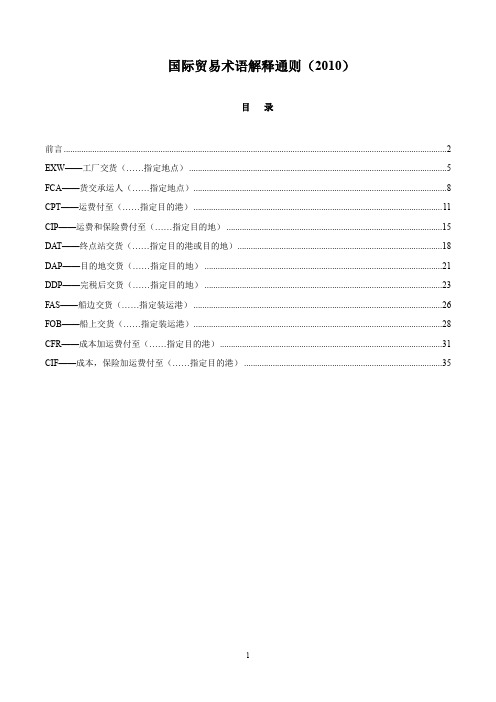
国际贸易术语解释通则(2010)目录前言 (2)EXW——工厂交货(......指定地点) (5)FCA——货交承运人(......指定地点). (8)CPT——运费付至(......指定目的港) .. (11)CIP——运费和保险费付至(......指定目的地) .. (15)DA T——终点站交货(......指定目的港或目的地) (18)DAP——目的地交货(......指定目的地) (21)DDP——完税后交货(......指定目的地) (23)FAS——船边交货(......指定装运港) .. (26)FOB——船上交货(......指定装运港).. (28)CFR——成本加运费付至(......指定目的港).. (31)CIF——成本,保险加运费付至(......指定目的港) (35)前言Incoterms 2010规则阐释了一系列在货物销售商业(商事)合同实践中使用的三字母系列贸易术语。
Incerotms 2010规则主要描述货物从卖方到买方运输过程中涉及的义务、费用和风险的分配。
如何运用Incoterms®2010规则1.将Incoterms®2010规则订入到你的销售合同中如果你要使Incoterms规则2010在你的合同中适用,你应该在合同中,通过如“所选择的Incoterms 规则(含指定地点)附上Incoterms规则2010”这类文字以明确表示。
2.选择适当的Incoterms规则所选的Incoterms规则须与货物、其运输方式相称,最重要的是与合同双方是否有意添加额外义务相称,例如安排运输或保险的义务于买方或卖方。
每个对贸易术语的指导性解释中都包含对做出此项决定非常有帮助的信息。
不论是哪一项Incoterms规则被选用,适用双方应该意识到对合同的说明会颇受到所用港口或地方特有的惯例影响。
3.尽可能精准地说明你所在地方或港口名称仅当当事人双方选定特定的一个收货地或港口时,所选术语才能发挥作用。
- 1、下载文档前请自行甄别文档内容的完整性,平台不提供额外的编辑、内容补充、找答案等附加服务。
- 2、"仅部分预览"的文档,不可在线预览部分如存在完整性等问题,可反馈申请退款(可完整预览的文档不适用该条件!)。
- 3、如文档侵犯您的权益,请联系客服反馈,我们会尽快为您处理(人工客服工作时间:9:00-18:30)。
COST AND FREIGHT 成本加运费CFR (insert named port of destination) Incoterms 2010 成本加运费(…指定目的港)GUIDANCE NOTE 序言This rule is to be used only for sea or inland waterway transport. “Cost and Freight” means that the seller delivers the goods on board the vessel or procures the goods already so delivered. The risk of loss of or damage to the goods passes when the goods are on board the vessel.该术语仅适用于海运或内河运输。
“Cost and Freight”是指当卖方将货物运至船上或取得已按此送交的货物,即完成交货。
当货物已运至船上时,货物灭失或损坏的风险发生转移。
The seller must contract for and pay the costs and freight necessary to bring the goods to the named port of destination.卖方还必须订立货物运至指定目的港的合同并支付成本和运费。
When CPT, CIP, CFR or CIF are used, the seller fulfils its obligation to deliver when it hands the goods over to the carrier in the manner specified in the chosen rule and not when the goods reach the place of destination.当使用CPT, CIP, CFR 或CIF等术语时,卖方承担其将货物按照所选规则指定的方式交付承运人前所有风险和费用,而当货物运至指定目的地后,由买方承担一切风险和费用。
This rule has two critical points, because risk passes and costs are transferred at different places. While the contract will always specify a destination port, it might not specify the port of shipment, which is where risk passes to the buyer. If the shipment port is of particular interest to the buyer, the parties are well advised to identify it as precisely as possible in the contract.此术语有两个关键点,因为风险转移和费用在不同的地方转移。
合同中通常会指定目的港,但可能并未指定风险转移至买方的装运港。
如果装运港与买方有特定利益,则当事人应尽可能精准地在合同中确定。
The parties are well advised to identify as precisely as possible the point at the agreed port of destination, as the costs to that point are for the account of the seller. The seller is advised to procure contracts of carriage that match this choice precisely. If the seller incurs costs under its contract of carriage related to unloading at the specified point at the port of destination, the seller is not entitled to recover such costs from the buyer unless otherwise agreed between the parties.当事人应尽可能精准地指定约定目的港中的具体交货地点,因为货物运送至该地点所需费用由卖方负担。
建议卖方订立与上述决定适宜的运输合同。
除当事人事先另有约定外,如果卖方根据其运输合同负担了有关货物在指定目的港卸载的费用,其无权要求买方偿还相关费用。
The seller is required either to deliver the goods on board the vessel or to procure goods already so delivered for shipment to the destination.In addition, the seller is required either to make a contract of carriage or to procure such a contract. The reference to “procure” here caters for multiple sales down a chain (…string sales‟), particularly common in the commodity trades.卖方必须将货物运到船上或取得已按此送交准备发运的货物。
此外,卖方必须订立运输合同或取得这样的合同。
这里的“取得”适合于多层次链条式销售(线性销售),在商品销售中尤为普遍。
CFR may not be appropriate where goods are handed over to the carrier before they are on board the vessel, for example goods in containers, which are typically delivered at a terminal. In such circumstances, the CPT rule should be used.CFR requires the seller to clear the goods for export, where applicable. However, the seller has no obligation to clear the goods for import, pay any import duty or carry out any import customs formalities.CFR不适用于货物在装船之前移交给承运人的情况,比如集装箱内的货物通常在目的地交付。
在这种情况下,应使用CPT术语。
在需要办理清关手续时,CFR要求卖方应负责货物的出口清关。
然而,卖方并没有义务办理货物进口清关、负担任何进口关税或办理任何进口海关手续。
A THE SELLER‟ OBLIGATIONS卖方义务A1 General obligations of the seller卖方基本义务The seller must provide the goods and the commercial invoice in conformity with the contract of sale and any other evidence of conformity that may be required by the contract. Any document referred to in A1-A10 may be an equivalent electronic record or procedure if agreed between the parties or customary.卖方必须提供符合销售合同规定的货物和商业发票以及按照合同约定必需的有同等作用的其他任何凭证。
以及经当事人同意或根据交易习惯在A1-A10中提到的任何有同等作用的电子记录或程序的凭证。
A2 Licences, authorizations, security clearances and other formalities许可,授权,安全许可和其他正式手续Where applicable, the seller must obtain, at its own risk and expense, any export licence or other official authorization and carry out all customs formalities necessary for the export of the goods.在需要办理清关手续时,卖方必须承担风险和费用获得任何出口许可或其他官方授权,办理货物出口所需的一切海关手续。
A3 Contracts of carriage and insurance运输合同和保险合同a) Contract of carriage运输合同The seller must contract or procure a contract for the carriage of the goods from the agreed point of delivery, if any, at the place of delivery to the named port of destination or, if agreed, any point at that port. The contract of carriage must be made on usual terms at the seller‟s expense and provide for carriage by the usual route in a vessel of the type normally used for the transport of the type of goods sold.卖方必须自付费用,按照通常条件订立运输合同,自约定交货地点,经由惯常航线,将货物用通常可供运输合同所指货物类型的海轮运至指定目的港。
